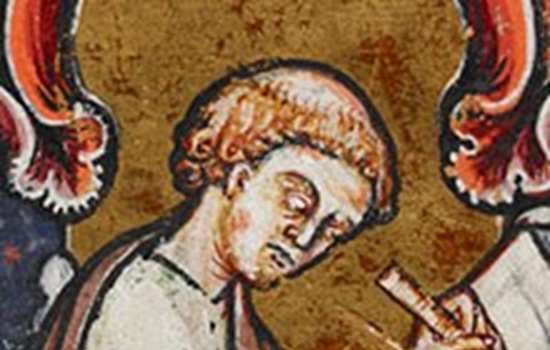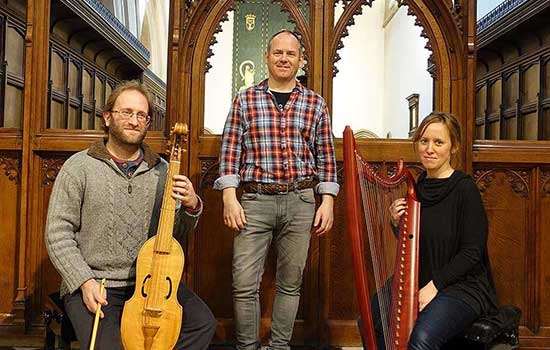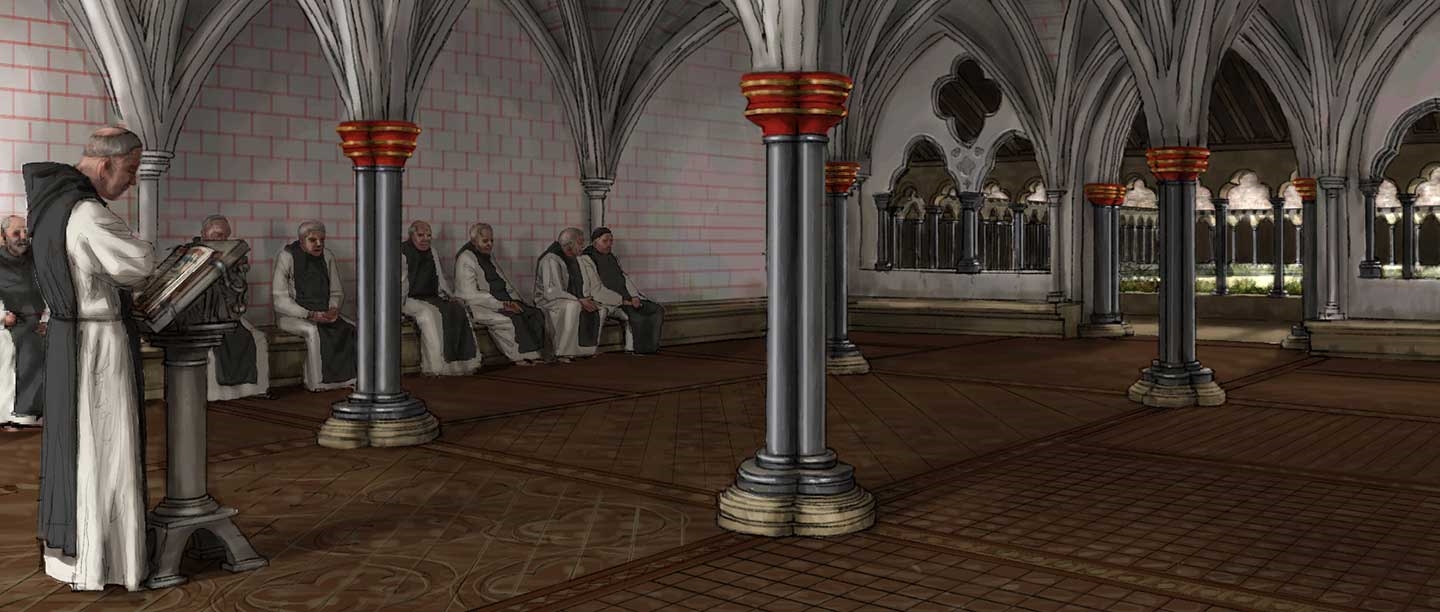I’m going to start by busting a widespread myth: medieval monks and nuns never had to take a vow of silence. But silence has been an important component of Christian monasticism ever since its origins in the 3rd century. The reasons why life within monasteries was characterised by silence, and the spiritual and theological importance that monks and nuns attached to the hush of the cloister, get to the very heart of the purposes of monastic life.
But as this article will explain, ideas about the meaning and purpose of monastic silence changed over the course of the Middle Ages and even the most observant of monks and nuns could struggle to maintain the silence demanded by their way of life.
The silence of the desert
The history of Christian monasticism stretches back to the late 3rd century when holy hermits such as St Anthony of Egypt (d.356) retreated to the arid, desolate wilds of the Middle East to live austere, solitary lives dedicated to Christ. Here they sought to liberate themselves from material concerns and the temptations of the flesh. Silence was integral to their hermetic existence, and this silence continued to be esteemed and mandated when groups of hermits began to band together and form monastic communities.
Life within these nascent communities was governed by a set of precepts called a Rule. The most important was written by St Benedict (d.547) for his monastery at Monte Cassino, midway between Rome and Naples. Silence is a constant theme in the Rule of St Benedict, which states that ‘monks should diligently cultivate silence at all times’.
This strict regulation of speech – the prohibition on unnecessary verbal communication – was an expression of the ascetic life of monks and nuns. It was meant to ensure that their thoughts did not become entangled in the preoccupations of the world outside the cloister, thereby distracting them from their lives of prayerful contemplation and quest for spiritual salvation – the core purpose of the monastic life.
Near total silence also curbed the opportunities for monks and nuns to become embroiled in the gossip and intrigue that had the potential to undermine the cohesion and the brotherly and sisterly love that were essential for harmonious communal life.
The angelic life on earth
Silence was elevated to an altogether more celestial significance in the 10th century by reforming monks at the French monastery of Cluny. By virtue of their sexual purity, elaborate sung liturgy and strict rules on silence, the monks of Cluny and its affiliated monasteries across Europe sought to emulate the angelic hosts in heaven.
Speech was all but forbidden, supervised conversation restricted to two short periods each day, one in the morning and another in the afternoon. Even then, the exchange of words was to be as brief as possible, the subjects restricted to what was absolutely essential for the wellbeing of the monastery.
Total silence reigned on important holy days; on Mondays, Wednesdays and Fridays in the penitential seasons of Advent and Lent; and also in the week following Christmas and Easter.
Conversation was forbidden in church, at mealtimes when the community dined together in the refectory while listening to an edifying reading from a spiritual text, and in the communal dormitory during the hours of darkness.
Silence and monastic reform
This Cluniac emphasis on silence resonated with the monastic reform movements of the 11th century, including the Cistercians. According to St Bernard of Clairvaux (d.1153), the Cistercians’ greatest saint, a life of silence was essential for the spiritual development of monks, promoting contemplation and reflection on the ‘things of greater importance’.
The rigour of the Cistercian way of life, including their strict insistence on silence, motived the young Aelred to join the order’s abbey at Rievaulx, where he rose to be abbot between 1147 and his death in 1167.
‘There is nothing you should pursue more than silence,’ wrote Aelred. Silence, according to Aelred, was a tool by which ‘idle and distrustful words, all distractions may be removed from our mind and heart’.
The solitary life of Carthusian monks – who spent most of each day praying and working alone in their individual cells in emulation of the hermits of the early Church – readily lent itself to the cultivation of silence. The reconstructed cell at Mount Grace Priory powerfully evokes their solitary way of life.
Silence also occupied an important place in the lives of the friars. Unlike the older orders of monks who lived secluded lives within their monasteries, the friars went out into the wider community, tending to the spiritual and physical needs of the laity. But when within the confines of their monasteries, they were expected to observe silence, especially in the cloister, church, dormitory and refectory. The Franciscan nuns, or Poor Clares, at Denny Abbey lived to similar rules.
Physical and spiritual punishments
The regulations concerning silence were rigorously enforced. Penalties for breaches were severe and could even include corporal punishment. This was administered in the monastery’s chapter house by the abbot or prior (or their female equivalents) before the entire community.
Other punishments included the reciting of penitential prayers and a diet of bread and water. At the end of the 15th century, canons at the abbeys of Egglestone and Leiston were placed on such meagre victuals after being chastised for chatting.
In 1523, it was the pockets, rather than the backsides, of the monks at Wenlock Priory that received a bashing, each violation of the rules on silence punished by a twopence fine. The monks of Hailes Abbey were somewhat more fortunate and escaped with little more than a stern telling off in 1270 for gossiping about the alleged (and disproven) sexual misdemeanours of one of their brethren.
Ghost stories were also used to frighten monks and nuns into adherence. A 13th-century tale recounts how the soul of a young nun endured the pains of Purgatory because of her habit of whispering to one of her sister nuns during church services. Her ghost appeared to her partner in sin to warn her of the fate that awaited her if she did not mend her ways.
Read more about the misbehaving monks of Hailes AbbeySign language
The premium attached to silence was such that a complex system of hand signals was used by monks and nuns for the purposes of communication. This developed at Cluny in the 10th century and included well over 100 individual signs, but only for nouns – for instance the sign for bread consisted of joining the tips of the thumb and index finger together to make a circle. This meant that a conversation using hand signs was impossible, although rules were nevertheless in place to prevent their misuse. The use of hand signs was entirely forbidden in the dormitory.
The use of signs spread rapidly to other monasteries and the presence of no fewer than 127 in a mid 11th-century manuscript from Canterbury Cathedral Priory shows that they were known in England before the Norman Conquest in 1066. The Cistercians and Carthusians developed their own separate sign languages and individual monasteries even had their own versions.
At the Benedictine abbey of Bury St Edmunds in the 14th century, there were 198 signs, the one for underpants being ‘pretend that you are drawing your hand on your thigh from below as one who puts on his underpants’.
The limitations of silence
Sound was, of course, also extremely common in and important to monasteries. The backbone of the monastic day was formed by the eight communal church services sung in praise of God. Speech was permitted for the instruction, education and religious edification of monks or nuns. ‘If the mutual exchange of words is pleasant, let our talk be of our way of life, or Scripture’, wrote Aelred of Rievaulx.
Talking was also allowed to ensure the smooth running of a monastery. Two rooms in the buildings around the cloister were allocated for their purpose: an inner parlour on the eastern side of the cloister, where monks and nuns would receive orders from their superiors about tasks they were to undertake, and an outer parlour on the west side of the cloister, where conversation was permitted with outsiders such as tradesmen and merchants, and even family members.
But even the most observant monks and nuns could find it hard to adhere to the high standards of silence demanded of them. Aelred of Rievaulx was so overcome with grief at the death of his friend and brother monk Simon that he violated the rules on silence.
For Aelred silence was a means to an end, and he could see times when conversation between monks had the same legitimacy as silent contemplation:
Let us sometimes grieve together over the afflictions of the world, at other [times] rejoice together in the hope of future happiness. Let us sometimes be refreshed by the mutual revelation of our inmost thoughts; at other times let us together express our longing for the blessed vision of Jesus and for heavenly riches.
It’s easy to understand why Aelred was such an inspirational leader for the monks at Rievaulx.
Read more about the life of St AelredAll England’s medieval monasteries were dissolved between 1536 and 1540 by Henry VIII, a key event in the English Reformation. Though these abbeys and priories have been ruined for centuries, visitors of all religious faiths and none continue to turn to them as places of contemplation, a source of spiritual nourishment where they can cultivate an inner silence.
‘Everywhere peace, everywhere serenity and a marvellous freedom from the tumult of the world’, wrote Aelred of Rievaulx. They’re words that echo over the centuries.
Read More
-

What Became of the Monks and Nuns at the Dissolution?
Discover what happened to the many thousands of monks and nuns whose lives were changed forever when, on the orders of Henry VIII, every abbey and priory in England was closed.
-

A Mini Guide to Medieval Monks
Many of the monastic sites in our care were once home to Benedictine, Cluniac, Cistercian and Carthusian monks. Watch this animation to find out more about these four major orders.
-

Easter: A Moveable Feast
A decision made at Whitby Abbey in AD 664 was a landmark in the history of Christianity in England. Find out more.
-

The Battle Abbey Carol
A chance discovery of a medieval carol has shed light on the lives of monks at Battle Abbey. Find out more and hear an extract of the piece.
